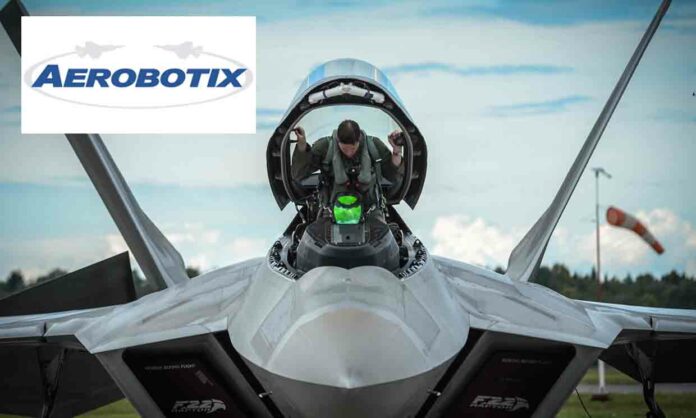HUNTSVILLE — Aerobotix today marked its 40th restoration of air inlet ducts on F-22 Raptor fighter jets. The work is part of a maintenance contract with the Air Force.
Developed with funding from the Air Force’s SBIR and STTR programs, Huntsville-based Aerobotix’s automated painting system restores the performance coatings on the ducts far more quickly, cost effectively and accurately than by hand.
“Our robotic technology can paint these units using only about 300 hours of labor, rather than 1,600 hours,” said project manager Bret Benvenuti, a senior robotics engineer at Aerobotix. “That’s a labor saving of around 80%, so it really solves the challenge of getting these aircraft back into service quicker.
“We estimate that since 2016, we’ve helped the Air Force save $8.8 million – $220,000 per aircraft – in maintenance costs.”
Aerobotix, an AS9100-certified FANUC (Fuji Automatic NUmerical Control) robotics integrator, refurbished its first F-22 in 2016 and is on track to restore its 50th by early next year.
The inlets ensure smooth airflow into jet engines despite turbulent air coming at the ducts from multiple directions.
Aerobotix’s automated painting solution not only achieves major labor savings, it also improves accuracy and quality control. This gives F-22 aircraft a better performance signature against radar.
Additionally, the automated system can apply more coating before the material’s pot life expires, significantly reducing waste. The highly engineered coatings cost around $1,000 per gallon, and more efficient use can save about $40,000 per aircraft.
“When you recoat jet-engine inlets manually, it requires maintenance workers to wear protective suits and respirators and spend hundreds of hours crawling around on their hands and knees inside the inlet,” said project lead Nathan Morgan. “Under those conditions, it’s nearly impossible for workers to manually apply the coatings at consistent speeds and thicknesses.
“Our robots achieve better results while also curbing the number of worker injuries.”
Aerobotix’s system uses two robots working at the forward and aft ends of the ducts to sand and spray-coat them.
Three of the automated systems have been installed at the F-22 depot at the Ogden Air Logistics Complex at Hill Air Force Base, Utah.
Recent upgrades include adjustable spray paths for certain areas of the inlets. Coating the lip area while the aft robot is spraying the inlets saves between two and three days of work.
Aerobotix is considering using the robots to simultaneously coat other exterior sections of the aircraft, which will achieve further labor savings.
Aerobotix has also developed similar automated painting systems for coating the F/A-18E and F/A-18F Super Hornet and F-35 Lightning II. Those aircraft are featured in the blockbuster movie “Top Gun: Maverick.”
“These are some of the Air Force’s best fighter jets, and Aerobotix is proud that our technology is supporting the jets’ combat readiness by getting them back in the sky faster,” said Benvenuti. “When you see the aircraft flying overhead, it really gives you a sense of accomplishment.”
Watch the video about the project.
Don’t miss out! Subscribe to our email newsletter to have all our smart stories delivered to your inbox.



